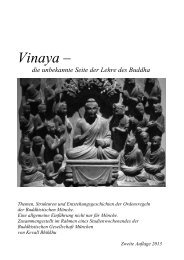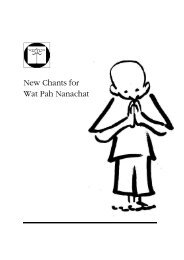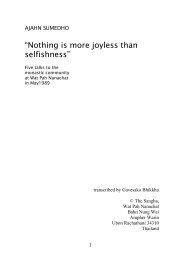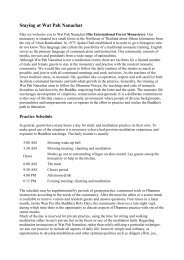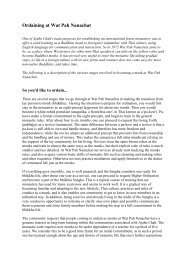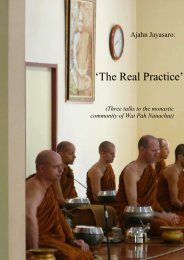Luang Por Liem: The Ways of the Peaceful - Wat Pah Nanachat
Luang Por Liem: The Ways of the Peaceful - Wat Pah Nanachat
Luang Por Liem: The Ways of the Peaceful - Wat Pah Nanachat
Create successful ePaper yourself
Turn your PDF publications into a flip-book with our unique Google optimized e-Paper software.
wear out. <strong>The</strong>y don’t consider <strong>the</strong> possibility, but it happens.<br />
Because in reality our physical body is a conditioned<br />
phenomenon, it will always follow <strong>the</strong> nature <strong>of</strong> its material<br />
constituents. Never<strong>the</strong>less we like to see <strong>the</strong> body as permanently<br />
powerful, tough and strong, not afflicted by disease and pain. We<br />
want to see it in this perspective, <strong>the</strong> way we are used to seeing it,<br />
just as if <strong>the</strong> body was fit for all circumstances. But <strong>the</strong> Buddha<br />
said, if <strong>the</strong>re is light, <strong>the</strong>re will be darkness. If <strong>the</strong>re is hot, <strong>the</strong>re<br />
will be cold. It has to be like this. So in this very way, any state <strong>of</strong><br />
strength, agility or ease may degenerate in just a single day or just<br />
a single moment into a state <strong>of</strong> decline and ruin, becoming<br />
deteriorated and worn out. It’s just following its nature. But if we<br />
cultivate an attitude <strong>of</strong> seeing <strong>the</strong> disintegration <strong>of</strong> <strong>the</strong> body as<br />
natural, we won’t be upset by <strong>the</strong> decline. We won’t take <strong>the</strong> body<br />
as something important, something to keep holding on to, or<br />
attaching feelings <strong>of</strong> self to it.<br />
<strong>The</strong> Buddha called <strong>the</strong> illusions we create around <strong>the</strong> body<br />
sakkayaditthi – <strong>the</strong> view that <strong>the</strong> body is self, that we and o<strong>the</strong>r<br />
people are our bodies, that <strong>the</strong> body is our possession. <strong>The</strong><br />
Buddha reminds us to keep recollecting that whatever thing <strong>the</strong>re<br />
may be, it is not ours, not our self. Nothing really belongs to us.<br />
Thinking like this prevents wrong courses <strong>of</strong> perception (agatidhamma)<br />
from gaining power. One can easily get lost in <strong>the</strong>se<br />
perceptions. <strong>The</strong>y stimulate feelings <strong>of</strong> self-importance in us. So<br />
<strong>the</strong> Buddha taught to counter <strong>the</strong>m by reflecting in one’s mind<br />
that <strong>the</strong>re is nothing that really belongs to us. Through thinking<br />
like this we won’t start holding on to things. Attachment is <strong>the</strong><br />
root <strong>of</strong> all self-importance<br />
123



